
Figure 8a: Block diagram showing the functional units in an Alpha EV7 processor.




Since the beginning of 2003 in Compaq machines like the AlphaServerSC, GS1280, and various cluster systems can be fitted with the Alpha EV7 processor. The latest implementation is the EV79, made in in 0.13 µm technology. Because of the EV7 structure the macro-architecture of these systems may also significantly change (see below). The core of the EV7 processor is almost identical to that of the EV6x architecture and is depicted in Figure 8a

Figure 8a: Block diagram showing the functional units in an
Alpha EV7 processor.
A notable fact is that there are two duplicate integer register files both with 80 entries, that each service a set of integer functional units called cluster 0 and cluster 1, respectively, by Compaq. The four integer Add/Logical units can exchange values in one cycle if required. Although this is not shown in the diagram, the integer multiply is fully pipelined. The two integer clusters and the two floating-point units enable the issuing of up to 6 instructions simultaneously. The two load/store units draw on a 64 KB instruction and a 64 KB data cache that are both 2-way set-associative. Four instructions can be accepted for (speculative) processing. Of the 80 integer and 72 floating-point registers 41 in both register files can hold speculative results. The out-of-order issuing of instructions is supported via an integer queue of length 20 and a floating-point queue with 15 entries. However, as the integer processing clusters do not contain the same functional units, the issuing of integer instructions cannot all be scheduled dynamically. Those instructions that need to execute in a particular unit (e.g., an integer multiply that is only available in cluster 0) are scheduled statically. As soon as an instruction is issued or is terminated due to mis-speculation it is removed from the queue and can be replaced by another instruction. Instruction fetching is governed by the branch predictor. This hardware contains global and local prediction tables and Branch History Tables (BHTs) to train the predictor in order to obtain an optimal instruction fetch to the instruction cache and registers.
The feature density used is 0.13 µm instead of 0.18 µm which enables the location of a 1.75 MB secondary cache which is 7-way set-associative and has a 12-cycle latency. Also there are 2 memory controllers on chip. The largest difference will be that there will be 4 dual channels (North, East, South, West) from the chip to interconnect it with neighbouring chips at a bandwidth of 6.4 GB/s per single channel for what HP calls "switchless SMP processing" and is, as the name suggests, well-suited to build SMP nodes with low memory latency. The layout of the complete chip is shown in Figure 8b
The path to memory is implemented by 4×5 RAMBUS links as the systems will
be fitted with RAMBUS memory yielding a bandwidth of 6 GB/s, so 12 GB/s in
total. The direct I/O dual link from the chip also has a bandwidth of 1.6
GB/s. The fastest EV79 implementation is shipped at a clock frequency of 1.3
GHz and is expected to still rise slightly in later implementations.

Figure 8b:
Chip layout for the Alpha EV7 processor.




Next:
Hewlett Packard PA-RISC 8800
Up:
The Main Architectural Classes
Previous:
AMD Opteron